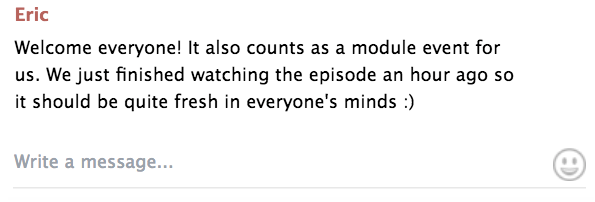Connor GRAHAM and Eric KERR
Tembusu College
Is it possible to develop and sustain in-depth conversations over online chat platforms? Connor and Eric discuss the benefits and limitations of applying these communication tools to their module seminar groups.

Our Questions
After a necessary period of being apart from students over the last months, it is sometimes hard to remember a face-to-face teaching experience. What seems central to such encounters, at least for seminar-style teaching, is conversation. But can real conversation be mediated using communication technology such as video-conferencing and chat platforms? And, is the face-to-face conversation, especially when deployed for teaching and learning, now under threat in a time of social distancing and ‘digital education’?
Our Context
Responding to a Business Continuity Plan, which physically separated the authors, we arranged Telegram ‘conversations’ involving students from three different Tembusu College modules. We used the Telegram platform to discuss a screening, which students had watched in their module seminar groups, because it permitted us to be present online together and to mix students from different modules and classes with relative ease.
The three modules concerned, with a focus on the Internet, fakes and knowledge, all supported students developing critical perspectives on Internet technology but each has a distinct learning focus: understanding and critiquing contemporary developments in living and dying online; examining how fakery is identified, judged and mediated; establishing how knowledge has been shaped and legitimised through history and by different figures and technologies.
Our ‘Conversation’
To maximise the diversity of students across modules in each conversation, we ‘time-boxed’ the ‘conversations’ into four different 15-minute chats across two days for real conversations. We began:

We even simulated a key aspect of a conversation to provide students with a model of sorts, when one of us posed a question to another in order to elicit a response:

In response to this question, the answer situated the current ‘conversation’ with regard to the screening:

Our final act of beginning the ‘conversation’ was to pose a very open question, one that many fellows use in face-to-face seminars:

In the course of the ‘conversation’, we encouraged students to move beyond ‘surface’ readings of the screening through probes, often in the form of “why”-type questions or comments that bridged to the modules’ themes. Students from the three modules were able to engage one another’s comments. Everyone contributed something and some performed the role of key participants, summarising lines of thought and generating new avenues for exploration. Others raised core theoretical concerns, which bridged the screening and the themes of their respective modules. One group developed a line of discussion quite pertinent to this post concerning technology and ‘being human’.
Our Reflections
The four chats alerted us to the different properties of online and face-to-face conversations, as well as the limitations of chat platforms for developing sustained and in-depth conversations. They also made us more aware of valuable techniques that we use in face-to-face seminars to instigate and propel a discussion forward.
We drew on Conversation Analysis (Sacks, 1992) for inspiration, especially the simple yet powerful observation that in face-to-face conversations “only one speaker speaks at once” (Tolmie, Procter, Rouncefield, Liakata, & Zubiaga, 2018, pp. 2, 9) and that certain sequences such as questions and answers tend to occur (adjacency pairing).
However, on social media platforms such as Telegram, there is frequent overlapping of conversation threads due to the absence of non-verbal cues signalling turn-taking. This and the recent use of Conversation Analysis to analyse Twitter (Tolmie et al., 2018) led us to elicit four key aspects of chats online, distinctly different from face-to-face conversations and requiring attention when using an online, primarily text-based, platform.
![]() Turn-taking: This was difficult to manage: multiple ‘threads’ developed, which was both good and bad. There was no way to offer immediate feedback on participants’ comments: the real-time expressiveness of Telegram was limited.
Turn-taking: This was difficult to manage: multiple ‘threads’ developed, which was both good and bad. There was no way to offer immediate feedback on participants’ comments: the real-time expressiveness of Telegram was limited.
![]() Flow: ‘Conversation’ tended to ‘lag’ at the beginning. This required intervention on our part through, for example, questions for clarification. However, we found that once the ‘conversation’ started it developed its own momentum and, once it did, unfurled very quickly!
Flow: ‘Conversation’ tended to ‘lag’ at the beginning. This required intervention on our part through, for example, questions for clarification. However, we found that once the ‘conversation’ started it developed its own momentum and, once it did, unfurled very quickly!
![]() Trust. ‘Conversations’ like these that are highly visible and screen-shotable, more permanent and archivable are profoundly distinct. Such ‘conversations’ also produce a particular kind of accountability when the participant can be held to account for what they write in text.
Trust. ‘Conversations’ like these that are highly visible and screen-shotable, more permanent and archivable are profoundly distinct. Such ‘conversations’ also produce a particular kind of accountability when the participant can be held to account for what they write in text.
![]() Self-awareness. Like many communication technologies (including Zoom), an intense awareness of self is produced through what you write being visible to yourself in an ongoing way. One’s contribution to a ‘conversation’ is highly visible and your name is marked next to your comments.
Self-awareness. Like many communication technologies (including Zoom), an intense awareness of self is produced through what you write being visible to yourself in an ongoing way. One’s contribution to a ‘conversation’ is highly visible and your name is marked next to your comments.
Based on what we learned, for later sessions, we set up expectations at the beginning. We intervened through questions to bring participants back ‘on topic’. We posted replies to particularly interesting or promising comments. We also tried not to ‘single out’ any participant for a comment unless we really had to, for example, when they were just plain wrong.
Our Concluding Thoughts
We have used scare quotation marks around the word conversation to emphasise that what takes place in online communication is a different kind of conversation. Often, against a romantic imagination produced by the apparent solutions that communication technologies provide, it is easy to miss the value of maintaining a critical perspective on how the ways in which we converse are shaped by technology (Pinch, Hughes, & Bijker, 2012) and the distinct properties and possibilities of ‘conversations’ online, across different platforms.
In addition, drawing on ‘social’ approaches like Conversation Analysis and Science, Technology, and Society (STS) provides a powerful way of examining and potentially improving everyday teaching-related practice.
Our Final Point
The success of grand imaginations associated with communication technology and the organisational logic driving them depend on the ordinary, everyday conversations of educators and students, humans, in the course of their teaching and learning to actually work. As a first step, acknowledging this everyday practice as important, effortful, and involving time and expertise seems central to designing effective learning experiences for students and recognising and rewarding good teaching.
 |
Connor GRAHAM is the Director of Studies and a Senior Lecturer at Tembusu College and a Research Fellow at the Asia Research Institute. For the last ten years, his teaching and research have centred on topics related to Science, Technology and Society (STS). Most recently, he has been teaching and researching Internet technologies in Asian societies, in particular the imaginations and narratives these technologies perpetuate, produce, and shape. Connor can be reached at rctccg@nus.edu.sg. |
 |
Eric KERR is a Lecturer at Tembusu College and a Research Fellow in the Science, Technology and Society Cluster at the Asia Research Institute. His teaching and research centres on issues around technology and the production of knowledge. He is Associate Editor at Social Epistemology and Editor for the Social Epistemology Review and Reply Collective. Eric can be reached at rctetk@nus.edu.sg. |
References
Lynch, M. (2007). The origins of ethnomethodology. In S. P. Turner, & M. W. Risjord (Eds.), Philosophy of Anthropology and Sociology (pp. 485-515). Amsterdam; Elsevier.
Pinch, T. J., Hughes, T. P., & Bijker, W. E. (2012). The Social Construction of Technological Systems: New Directions in the Sociology and History of Technology. Anniversary Edition. Cambridge, Mass: MIT Press.
Sacks, H. (1992). Lectures on Conversation, (G. Jefferson, Ed.). Oxford: Blackwell.
Tolmie, P., Procter, R. Rouncefield, M., Liakata, M., & Zubiaga, A. (2018). Microblog analysis as a program of work. ACM Transactions on Social Computing, 1(1), 1-40.
Acknowledgements
We wish to thank all the students in the “Fakes”, “Living and Dying in the Internet Age” and “Technology and the Fate of Knowledge” modules, and especially those who participated in the chats we reflect on here. A special thanks goes to those who provided us feedback on earlier drafts of this piece, Jeremy Fernando and Johan Geertseema in particular.

